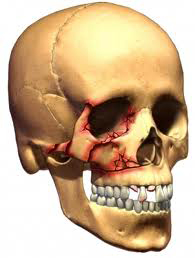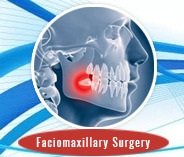Facial fractures are fractures (broken bones) of the face and jaws. They commonly include fractures of the cheekbones (zygomatic bone), area surrounding the eyes (orbit), nasal bone fracture and upper (maxilla fracture) and lower (mandibular fracture) jaws. Such kinds of maxillofacial trauma can occur singly (such as a broken nose) or in a combination (such as occurs in a severe motor vehicle accident).
If you have a facial fracture, the oral and maxillofacial team will usually want to check that you don’t have other fractures of or injuries to the head or neck and if you have been knocked unconscious.

What causes facial fractures?
Most facial fractures are acute (sudden) and caused by assaults (e.g. fighting), sports (e.g. horse riding, football and rugby) and accidents (e.g. road traffic or falls). Rarely, you might get a fracture following other treatment – sometimes this is because the bones are weakened by conditions such as dental cysts.
Injury to the face and facial bones fractures can produce damage to both the skin and the deeper bony structures. Nasal bones and the nasal septum (the wall-like structure in between the nostrils) can be fractured or disrupted as can the facial skeleton which supports the eyeballs and the teeth. Depending on the extent of injury, other structures within the face may require treatment as well. Some facial injuries may be very minor and not require operative treatment. Surgical treatment of facial injury/fracture is performed to repair soft tissues or damaged structures such as broken nasal bones, or to replace and fix broken bones. Facial fracture repair surgery is intended to minimize potential deformities due to abnormal healing of displaced bony structures. Left untreated they can result in functional and cosmetic impairments.
Treatments for Facial Fracture Repair
The treatment options that you will be offered will depend on the type and extent of the fracture and any other problems you might have at the time.
In general, doctors will want to bring the broken bones back into a normal alignment (called ‘reducing’ the fracture) and keep it/them in this place (called ‘fixing the fracture’), preventing further injury. Sometimes they will need to operate to do this. Sometimes they will need to use plates, screws or wires (or other fixation) inside or occasionally outside the bones to hold the fractures in place. Your Oral and Maxillofacial Surgeon will explain more about your fracture(s) and its treatment.
Alternative Treatment
Alternative forms of treatment consist of not undergoing the facial injury/fracture repair surgery. Risks and potential complications such as the possibility of visible and palpable malformations, breathing problems, visual disturbances (e.g. double vision), disturbed chewing ability, and persistent numbness are associated with non-treatment of facial injury/fracture injuries.
Recovery after a facial Fracture
How long it takes a facial fracture to heal will depend on the type and extent of fracture and what other problems and treatment you had. Bruising and swelling usually takes 2 to 3 weeks to settle down. At this point, you will begin to look more normal. After this time the body will continue to heal itself inside.
Financial Responsibilities
The cost of surgery involves several charges for the services provided. The total includes fees charged by your doctor, the cost of surgical supplies, anaesthesia, laboratory tests, and possible outpatient hospital charges, depending on where the surgery is performed. Depending on whether the cost of surgery is covered by an insurance plan, you will be responsible for necessary co-payments, deductibles, and charges not covered. Additional costs may occur should complications develop from the surgery. Secondary surgery or hospital day surgery charges involved with revisionary surgery would also be your responsibility.















